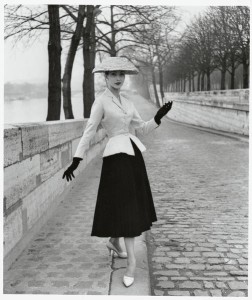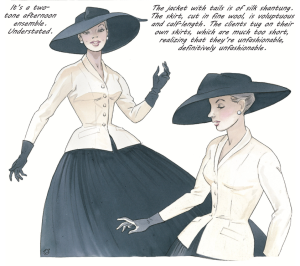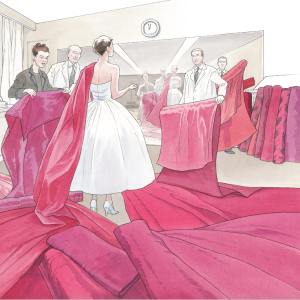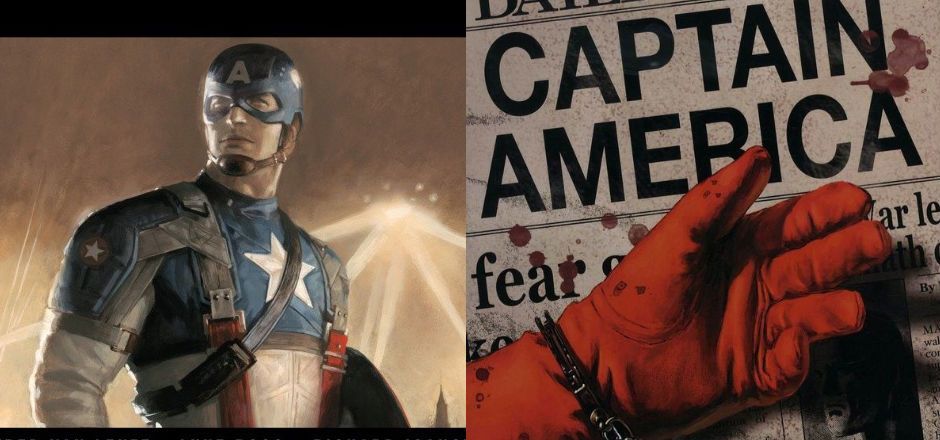For the first time, I found myself inside the enchanted world of high fashion.
—Clara Nohant, Girl in Dior
I have designed flower women.
—Christian Dior, on his collection Corolle/New Look
What fashion aficionado wouldn’t want a dinner with Christian Dior? Any self-respecting fashionista would give anything to pick the brain of a man like Dior, regularly called the father of French haute-couture. In her graphic novel Girl in Dior, Anne Goetzinger gives us the opportunity to do just that.
Through the eyes of main character Clara Nohant, the reader has a window into the backstage of the Dior fashion house from its very inception. We see how, by a twist of fate, Clara changes careers from fashion writer to fashion model, and thus commences her journey into the world of high design.
Goetzinger is a best-selling French graphic novelist and cartoonist, whose first graphic novel, Casque d’or, won two prizes at the prestigious Festival d’Angoulême. She went on to publish the graphic novel Aurore, followed by many other historical and crime comic books. Girl in Dior is her first graphic novel translated into English. While at first glance, this book seems about a girl and her Dior dresses, the story has many thematic layers one can identify with. Whether you’re into fashion or not, it’s an interesting read with beautiful artwork to match.
Up: Dior’s Bar dress (1947); Down: Girl in Dior, p. 21
The year is 1947, the location: Paris. The world is changing rapidly, and so is the fashion industry. Both are a reflection of the other. It is two years after the end of World War II, the same year that Christian Dior debuts his first collection New Look, a name coined by Carmel Snow, then editor-in-chief of Harper’s Bazaar. Both bread and fabric rations were a daily reality for many a Frenchman, but Dior’s designs were more voluptuous than the rather boxy, fabric-conserving shapes of World War II styles, which were by the rations on fabric.
But “[i]n the presence of elegant casual wear, luncheon and afternoon suits, dresses for dancing, for the mid-evening for late-night,” “[w]ho remembers the trafficking, the profiteers, and even the war now?” With his glamorous dresses, Dior has “the audience . . . dreaming of parties of the high life.”
“Post-war is so beautiful,” says a working class man looking at the models. “Even before the war, we didn’t have things this beautiful.” Dior helped restore post-war Paris as the capital of fashion, presenting a total of 22 collections from 1947 to 1957. The novel shows us a very different time for the fashion industry; the business might not have changed, but the way it’s run has clearly evolved.
Fashion aficionados will already be familiar with the dresses and collections, but in Girl in Dior the reader will also get to know the man behind the ideas, the women behind the man, and the girls behind the dresses. At one point, Dior says, “Understand, Clara, that the linen is to the dress like a caterpillar is to a butterfly.”
Throughout the novel, the reader experiences how Clara goes through a metamorphosis of her own, from fashion writer to fashion model to fashion consumer. Clara is not just a coat hanger, who models Dior for all to see (and buy), but a girl with ambitions and dreams of her own. As her story evolves, we see how her life has been enriched by fashion. While the underlying rags-to-riches story is nothing new, Goetzinger’s storytelling adds a different flavor to the mix. The way Clara’s and Dior’s story is told, combined with the tasteful artwork in the book, compels the reader to move forward with the narrative.
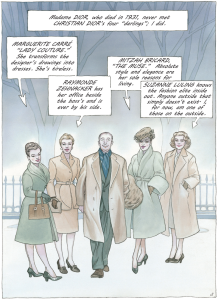
Dior’s Darlings, Girl in Dior, p. 3
Goetzinger’s style does an excellent job of capturing the essence of both the time period, and the different Dior collections that are displayed. The artwork is so delicately done, that it as pleasing to the eyes as silk is to the touch. While the color palatte is not typical of graphic novels and comic books, the pastels that Goetzinger uses calm the senses, which makes the colorful dresses really pop out. Just as your eyes start to feel relaxed by the soothing soft pinks, greens, and beiges, they receive a jolt of color and sensation when the models come out strutting in shocking reds and eye-catching blues. Goetzinger adds color to the page the same way Christian Dior added color and life to a dull, beleaguered Paris with his designs.
Both the art and the story evoke a type of femininity that feels empowering on its own. Throughout the story we see Clara face many challenges, but as she embraces fashion and becomes the “girl in Dior,” whether she is accompanied or alone, she keeps control over the reins of her life. Not content to merely be an object of appraisal, she wears the clothes she is modeling as an extension of her own femininity. Rather than hide her personality, she takes every opportunity to let it shine through the fashion she models, whether it be on the floor of the salon or on the streets of Paris. This is something many women and men identify with, and –despite the flaws the industry may have,– it’s the reason why many of us enjoy fashion.
If I had to pick a criticism, I would go with the rather shallow romantic sub-plot. It doesn’t really fit with the rest of the book, wasn’t properly explored, and the guy had no personality besides the fact that he was British nobility. Overall it just felt very rushed, almost giving the impression that it was bound to happen that Clara would find a husband and get married. The story itself also ends quite suddenly, but then again, the best things in life usually do. Overall, the main part of the book is executed so well, and with such loving attention to detail, that these few minor gripes are easy to forgive.
Many will agree that Dior has been one of the most influential figures in the industry, and his ability to build a fashion house that would last throughout the decades in such short time (10 years!) is astounding. Girl in Dior serves him justice.
4 out of 5 stars
—
Katherine Elisa Ruiz-Díaz is a Graphic Novel Reviewer at Girls in Capes from Puerto Rico. She holds a B.A. in History, with minors in French and Biology, from Boston University, and is currently pursuing a degree in Law. She enjoys reading anything related to sci-fi and fantasy, and hides under the covers to read non-fiction and history books. Katherine is also an anime and TV junkie, and thinks that RPGs are the only video games truly worth playing. When she’s truly bored, she likes to sketch and paint. Find her on Goodreads.

